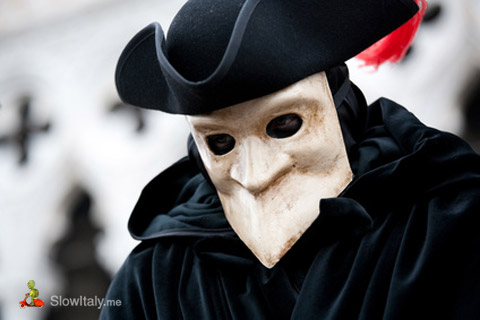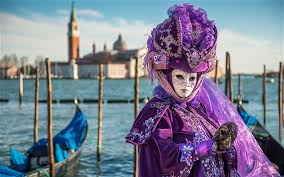The history and characters of Venice’s spectacular Carnivale are just as varied as the masks and colorful garments which have traditionally populated it. Legend has it that the bombastic celebration of all things artistic started following the military victory of the Venetian Republic over the Patriarch of Aquileia, Ulrico di Treven in the year 1162. Rejoicing at the victory, the people started to dance and gather in San Marco Square.
Becoming an official event during the Renaissance, it was not until the seventeenth century that the Baroque Carnival was used as a way of preserving the image of Venice as a city of prestige to the rest of the world. Its popularity increased to greater heights in the eighteenth century as a means of reducing civil unrest. Unfortunately, the festival was outlawed entirely in 1797 under the rule of the Holy Roman Emperor and later Emperor of Austria, Francis II. The use of Carnivale masks became strictly forbidden.
The festival made a comeback over the nineteenth century, but the focus shifted towards prioritizing private feasts and opening up the event to a wide variety of artisans. The Carnival returned in 1979, when the Italian government decided to bring back the history and culture of Venice. Mask-making skyrocketed after some Venetian college students pursued this centuries-old hobby for the satisfaction of tourist trade. It is said that approximately 3 million visitors come to Venice every year just to celebrate the Carnival.
 Those who enjoy the artistic beauty of masks will always find plenty to be impressed by at the festival, in particular the contest for la maschera più bella (“the most beautiful mask”), judged by a panel of international fashion and costume designers. The masks themselves have always been an important part of Venice’s Carnival. In its early days, people were allowed to wear them between the festival of Santo Stefano (St. Stephen’s Day, December 26) and the end of the carnival season at midnight of Shrove Tuesday (usually held during February or early March). As masks were also allowed on Ascension and from October 5 to Christmas, people could spend a large portion of the year in disguise.
Those who enjoy the artistic beauty of masks will always find plenty to be impressed by at the festival, in particular the contest for la maschera più bella (“the most beautiful mask”), judged by a panel of international fashion and costume designers. The masks themselves have always been an important part of Venice’s Carnival. In its early days, people were allowed to wear them between the festival of Santo Stefano (St. Stephen’s Day, December 26) and the end of the carnival season at midnight of Shrove Tuesday (usually held during February or early March). As masks were also allowed on Ascension and from October 5 to Christmas, people could spend a large portion of the year in disguise.
As a result of this booming mask industry, Venetian mask makers (known as mascherari) enjoyed something of a privileged social position in the Carnival’s early years. They had their own guild, and honed their craft by importing leather, porcelain and certain types of glass. In modern times, the majority of genuine Italian masks are made with the application of gesso and gold leaf and are hand-painted using natural feathers and gems to decorate. It is likely that each mask, while unique in certain elements of form and decoration, will belong to one of several distinct styles. Let’s peruse some of the most popular options!
 The bauta is a mask which features an odd, but incredibly practical design element. Originally a simple white, it was fashioned to comfortably cover the entire face, and bauta today are heavily gilded in something of a gaudy fashion. Characterized by an over-prominent nose, and a face shape which looks something like an upside-down pentagon. The beak-like chin bears no opening for the mouth, but projects outwards to enable the wearer to talk, eat, and drink without having to remove it.
The bauta is a mask which features an odd, but incredibly practical design element. Originally a simple white, it was fashioned to comfortably cover the entire face, and bauta today are heavily gilded in something of a gaudy fashion. Characterized by an over-prominent nose, and a face shape which looks something like an upside-down pentagon. The beak-like chin bears no opening for the mouth, but projects outwards to enable the wearer to talk, eat, and drink without having to remove it.
Traditionally, the bauta is accompanied by a red or black cape and a tricorn hat. This mask was endorsed for use by the Venetian government during the 18th century. In addition to a black circular or semicircular clasped cape called a tabarro, it was a required piece of uniform at certain political decision-making events (especially when the involved citizens were required to act anonymously as peers). The bauta is a stately authoritative mask, and makes one look quite the dashing commodore when paired with a tricorn.
Legend has it that female mask-wearers were disappointed at the ancient decree that only men should wear the bauta, so female mask-makers made them a subsequent design of their own.The Colombina is a half-mask, covering the wearer’s eyes, nose, and upper cheeks. Often highly decorated with gold, silver, crystals, and feathers, it can be held up to the face by a baton or tied with a ribbon at the back for dancing. Named after a stock character in the Commedia dell’arte, Colombina was a maidservant who was an adored part of Italian theatrical productions for generations. Some claim that it was first created for an actress who did not wish to have her beautiful face covered completely. However, there are no historic paintings depicting its use on the stage, and it seems to have been a modern invention primarily intended for use at masked balls.
 The Larva (meaning ghost in Latin) is another iconic modern Venetian mask, one which is often made of white porcelain or plastic. It is frequently decorated, and like the bauta can be commonly observed on Carnival attendees worn with a tricorn and cloak. Heavier than a typical mask and with a much tighter fit, it is secured in the back with a ribbon. The Larva covers the entire face of the wearer and extends farther back to just before the ears. Depicting the nose and lips in simple facial expressions, this mask is nearly impossible to wear while eating and drinking. As the Larva was never a stock character in Commedia Dell’arte, the design of this mask has not been reworked to feature a hinged jaw.
The Larva (meaning ghost in Latin) is another iconic modern Venetian mask, one which is often made of white porcelain or plastic. It is frequently decorated, and like the bauta can be commonly observed on Carnival attendees worn with a tricorn and cloak. Heavier than a typical mask and with a much tighter fit, it is secured in the back with a ribbon. The Larva covers the entire face of the wearer and extends farther back to just before the ears. Depicting the nose and lips in simple facial expressions, this mask is nearly impossible to wear while eating and drinking. As the Larva was never a stock character in Commedia Dell’arte, the design of this mask has not been reworked to feature a hinged jaw.
The Zanni are masked characters who often play supporting roles in commedia performances, often fulfilling societal roles such as a local policeman or shopkeeper. Zanni masks take several different shapes, but they all share several features in common: their half mask is made of leather, featuring a low forehead, bulging eyebrows and a long nose with a reverse curve towards the end. In Commedia Dell’arte, a long nose denotes a character’s stupidity (as does a low forehead). One of the most recognized of the Zanni is Arlecchino, meaning harlequin, who is meant to be a servant devoid of reason and full of emotion. His originally wooden and later leather half-mask depicts him as having a short nose, a set of wide, round, arching eyebrows, a rounded beard, and always a “bump” upon his forehead.
The most well-known mask at Carnival is easily Pantalone, the lecherous old man whose name stems from the Italian “pianta il leone”. This bawdy reference to the character’s many lovers in Venice is only a veneer… for Pantalone is usually represented as a sad old man with an oversized nose like the beak of a bird, with high eyebrows. A half-mask worn almost exclusively by men, its popularity has begun to wane in recent years. With so many different interpretations on these classic characters, its no wonder that Carnival continues to be a Mecca of sorts for mask-enthusiasts everywhere, year after year. We hope you enjoy the dazzling sounds of the Venetian Carnival in our concert, featuring your Saskatoon Symphony Orchestra.
